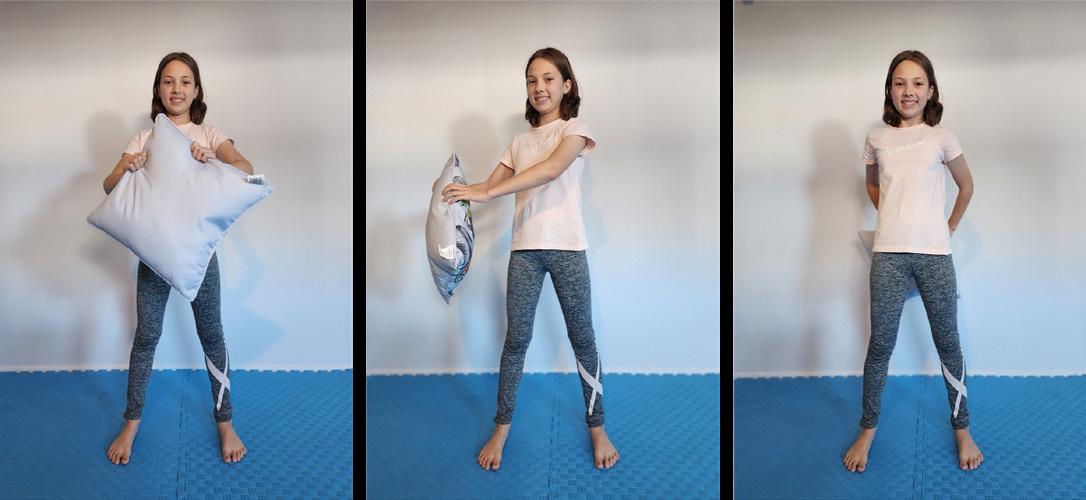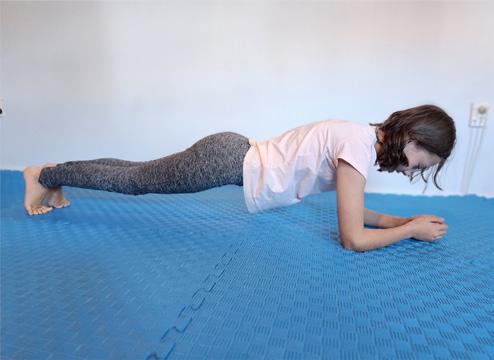
6 minute read
FLICK THAT SWITCH
Sore back? Switching on our core can remedy this. Craig Wise shows us how we can strengthen our core by wood chopping, travelling around the world, and becoming a dead bug. Exercises are demonstrated by Xanthia Wise.
Recently, as I collected my girls from school, I watched another parent removing their squirming toddler from the car. As she stood up, she made the universal sign for a sore back: palms on the lower back, elbows sticking out like chicken wings. Following a brief chat, she told me that since the birth of her two children she had almost constantly lived with a ‘bad back’. However, she was mistaken. Her back wasn’t bad, her core was.
A strong core is an integral part of being able to do physical activities and maintain our balance, which becomes an increasingly important ability as we age.
PAIN AND BAD BALANCE
There are four main signs of a weakened core area: lower back pain, poor posture, balance issues, and difficulty standing for extended periods of time.
There are many times in our daily life when core engagement is a key factor in keeping our bodies safe. These include everyday activities such as picking up the kids, reaching into the back of the car to grab the bag of groceries, and bending over to pick something up, even something as seemingly gentle as walking up and down stairs.
Strengthening the core involves targeting the muscles that connect the spine to the pelvic girdle and shoulders. This group of muscles gives us our correct posture and works with our glutes and legs to control movement.
HOW TO SWITCH ON THE CORE
Engaging the core means tightening and bracing all the muscles in the core to keep the spine stable and safe as you perform a task. There are many ways to switch on your core, but the simplest way might be to imagine that you are about to be punched in the stomach and brace yourself for the impact. Another
way of looking at it is to imagine you are zipping up your abdominal muscles, drawing your navel up towards your spine. Here we have a set of five exercises that, if done a few times a week, will strengthen your core. Mercifully, there are no crunches or sit-ups involved. These exercises
might be fabulous for ‘feeling the burn’, but they are useless for strengthening the core. Instead, try the following exercises as a combination. Start with two sets of 10 and eventually increase to three sets of 15. Consistent training should lead to a noticeably stronger core in four to eight weeks.

MARCHING WITH A PAUSE
Stand with your hands on your hips. Slowly bring one leg up until your thigh is parallel to the ground. Hold for a count of three and lower back to the ground. Do a set on one leg and then on the other leg. When you find yourself getting good at it, try holding a cushion above your head to make it a little trickier.

AROUND THE WORLD
With your feet in the same position, hold the cushion just below chest height. Pass the cushion around your back in a clockwise direction, pass it to your other hand and bring it back to the starting point. After you have completed a set in a clockwise direction, repeat with another set in an anticlockwise direction. You can exchange the cushion for a hardback book, bottle of water, or kettlebell if you have one.

STANDING SIDE CRUNCH
Stand with your feet shoulder width apart. Place one hand on your hip and raise the other high into the air. Bring your elbow down as you raise your knee to meet it. Do a set on one side and then repeat on the other.

WOOD CHOP
Grab a cushion and stand with your feet wider than shoulder width. Holding the cushion out in front of you with both hands, come down into a low squat by your left knee and then sweep the cushion up high toward the ceiling on the opposite side, straightening your legs and lifting your left heel. Swap sides. You can exchange the cushion for a heavy book, an old milk bottle filled with water, or a weight if you have one.

DEAD BUG
Lie on your back with your arms and legs in the air. Put a bend in your legs, as if you’re sitting on a chair. Pull your navel into the floor to prevent your lower back arching. Slowly lower your right arm above your head. and keep your left leg bent at 90 degrees. Lower that too. When you feel the heel of your foot touch the ground, bring it back up to the start position. Repeat with the right arm and left leg.
When you are comfortable doing this exercise with the leg bent, advance to doing it with your leg extended.

THE PRONE HOLD
When you have mastered those other exercises and feel ready for a challenge, use this as a test of how well you can control those abdominal muscles.
Begin by lying on your front on the floor and then prop yourself up on your elbows with your body nice and straight, core fully engaged. Be careful not to poke your bottom up into the air.
Begin holding for 15–30 seconds, and slowly work your way up to a minute or more.










